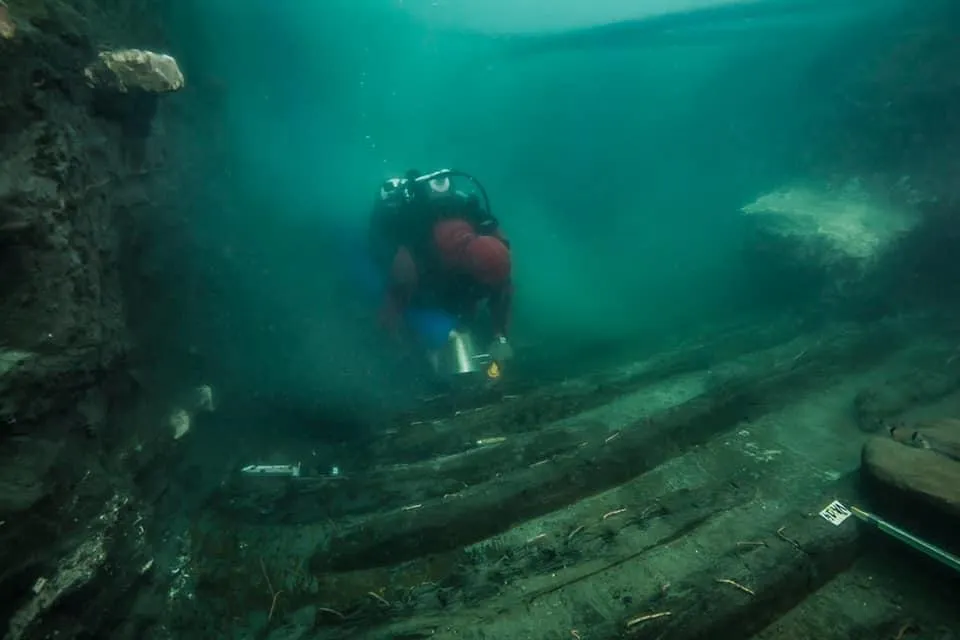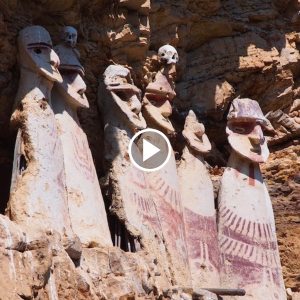 An Egyptian-French mission found the 80-foot-long ship beneath roughly 16 feet of hard clay. Photo: Christoph Gerigk © Franck Goddio / Hilti Foundation
An Egyptian-French mission found the 80-foot-long ship beneath roughly 16 feet of hard clay. Photo: Christoph Gerigk © Franck Goddio / Hilti Foundation
Divers exploring the sunken city of Thônis-Heracleion, in the Egyptian bay of Abū Qīr, have discovered the remains of a military vessel dated to the second century B.C.E. The ship was moored beside the city’s Temple of Amun when the building collapsed, sinking the boat under the weight of the structure’s large blocks, Reuters reports.
An Egyptian-French mission led by the European Institute for Underwater Archaeology (IEASM) found the 80-foot-long ship beneath roughly 16 feet of hard clay, reports Nehal Samir for Daily News Egypt.
The ship’s design reflects a mixture of ancient Egyptian and Greek techniques. Its builders used mortise-and-tenon joints and constructed the vessel partly out of reused wood, suggesting that it was made in Egypt. The ship boasted both oars and a large sail; it had a flat bottom and keel, which would have allowed it to navigate the Nile and the delta where the river meets the Mediterranean Sea.
Franck Goddio, founding president of IEASM, says in a statement that finding intact remains of such ancient, fast ships is very rare. The only comparable Greek-style ship is the Marsala Ship, dated to 235 B.C.E., which archaeologists uncovered in western Sicily in 1971.
Per Reuters, Thônis-Heracleion was Egypt’s greatest Mediterranean port prior to Alexander the Great’s foundation of Alexandria, situated about 14 miles to the west, around 331 B.C. Previous underwater excavations at the site have uncovered ritual artifacts, ceramics and bronze coins dated to the reign of Ptolemy II (285 to 246 B.C.E.), as Benjamin Leonard reported for Archaeology magazine in 2019.
The temple itself was destroyed around 140 B.C.E. Much later, in the eighth century C.E., the entire city, along with the neighboring community of Canopus, was submerged following a series of earthquakes and tidal waves.
 In addition to the ship, the new excavation uncovered a large Greek cemetery dated to the early fourth century B.C.E. Egyptian Ministry of Tourism and Antiquities
In addition to the ship, the new excavation uncovered a large Greek cemetery dated to the early fourth century B.C.E. Egyptian Ministry of Tourism and Antiquities
IEASM and the Egyptian Ministry of Tourism and Antiquities’ Underwater Archaeology Department rediscovered Canopus in 1999 and Thônis-Heracleion in 2001, according to Egypt Independent.
In addition to the ship, the new excavation uncovered a large Greek cemetery dated to the early fourth century B.C.E. At the time, Greek merchants lived in the city and had established their own institutions there. Archaeologists exploring the Temple of Amun’s underwater ruins have also found Doric columns of a Greek temple, per Archaeology.
Goddio’s website notes that Thônis-Heracleion reached its most impressive stage between the sixth and fourth centuries B.C.E., acting as a major center of maritime activity. The city extended all around the temple, with a network of canals connecting different parts to surrounding areas. Homes and secondary religious buildings were located on islands around the city center.
As Emily Sharpe reported for the Art Newspaper in 2016, prior to the sunken city’s rediscovery, scholars had not realized that the city of Heracleion, described by Greek historian Herodotus in the fifth century B.C.E., was the same place as Thônis, which is the city’s Egyptian name. A tablet that Goddio’s team found in the city in 2001 made this fact clear.
Goddio told the Art Newspaper that preserving objects found underwater is a laborious practice. The recovery of a huge statue of the Nile god Hapi from Thônis-Heracleion took two-and-a-half years.
“This would be a big undertaking on land,” Goddio said. “But under the sea and under the sediment, it’s a task that will take hundreds of years.
Get the latest stories in your inbox every weekday.
Recommended Videos
Filed Under: Ancient Civilizations, Ancient Egypt, Ancient Greece, Archaeology, Boats, Cities, Egypt, Military, Ships, Shipwrecks





